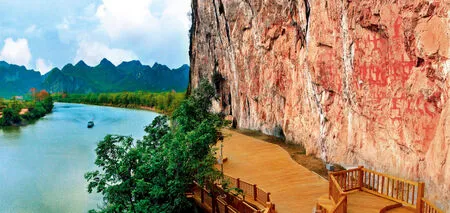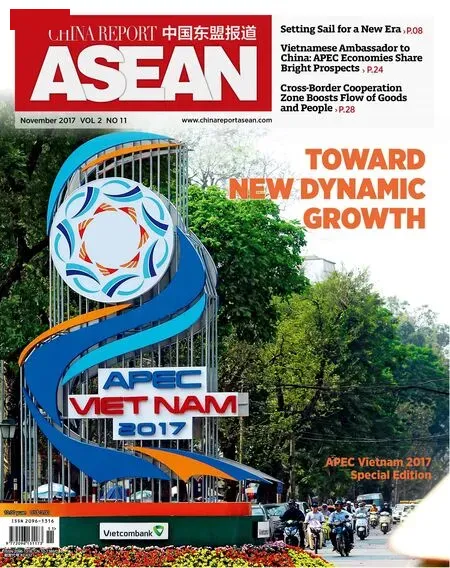CHONGZUO AT FOREFRONT OF REGIONAL TRADE
2017-11-22ByWangJiping
By Wang Jiping
CHONGZUO AT FOREFRONT OF REGIONAL TRADE
By Wang Jiping
Border city in Southwest China’s Guangxi Zhuang Autonomous Region facilitates import and export with land ports and financial cooperation

Zuojiang Huashan Rock Art Cultural Landscape, a World Heritage site.
Chongzuo, a prefecturelevel city in Southwest China’s Guangxi Zhuang Autonomous Region, shares a border with Vietnam to the west. In recent years, with the implementation of the Belt and Road Initiative,China-ASEAN relations have become increasingly close. This famous border city has not only become the most convenient land passageway from China to ASEAN, but also an important hub on Vietnam’s Two Corridors and One Economic Circle, as well as a pivot along the Nanning-Singapore Economic Corridor.Chongzuo has also joined the city cluster of the Guangxi Beibu Bay Economic Zone with its rapid development.
City of Land Ports
As an important border city at the forefront of China’s openingup to ASEAN, Chongzuo’s most prominent feature and advantage is its land ports.“Chongzuo has three national first-class ports, four secondclass ports and 13 border trade zones. The city has the most land ports in China,” explained Liu Youming, delegate to the 19th CPC National Congress and secretary of the Chongzuo Municipal Party Committee,during the 19th CPC National Congress. “It is also a hub along the Belt and Road with obvious advantages for opening-up.The total volume of the city’s imports and exports increased at an average annual rate of 37.4 percent, from US$226 million in 2003, when the city was first designated as a prefecture-level city, to US$18.57 billion in 2016.For eight years in a row, the city performed best in imports and exports in the entire Guangxi Region. It also performed best in cross-border trade RMB settlement across the region,with an amount reaching US$13 billion in 2016. That figure is expected to exceed US$20 billion this year.” Additionally, in terms of opening-up platforms,Chongzuo will experiment with platforms available, including“the Pingxiang pilot zone for development and openingup” and “the border pilot zone for comprehensive financial reform”, to attract more investment and projects and build more platforms.
“According to the requirements of General Secretary Xi’s report to the 19th CPC National Congress, we will open the city wider to the outside world for all-round opening-up,” Liu added. “We’ll transform our economy from a passageway economy to a land port economy. That is to say, we’ll bring into full play the advantages of the land port to develop related industries,including manufacturing,logistics, cross-border tourism and rural tourism, what we have referred to as ‘land port-plus’.”
Liu said that in order to promote the development of the land port economy and economic and trade cooperation between China and ASEAN countries, his city has in recent years been working on the following initiatives.
First, the construction of a modern multidimensional transportation system. The city has successively invested over 6 billion yuan (US$900 million) on improving the infrastructure of the land port and the border trade markets.Several expressways linking Chongzuo with ASEAN,including Nanning-Youyiguan(Friendship Pass), Chongzuo-Qinzhou and Chongzuo-Jingxi,have been built. The building of the Zuojiang international golden waterway is proceeding smoothly. So are the crossborder projects, such as the Nanning-Pingxiang-Hanoi Railway and the New Shuikou-Ta Lung Bridge.
Second, the facilitation of trade and customs clearance.Chongzuo has continuously upgraded the services of its land ports, including the processing of international trade through a single window, with one stop services. It has experimented with 24/7 clearance services with appointment. It has also explored“joint single window” service with the Vietnamese port authority for more efficient clearance.The clearance time for business companies has been cut by half.The average clearance time at Pingxiang port is just over eight minutes, the best in the region.

Local government officials at the launch ceremony of the freight clearance special lanes at Youyiguan, Pingxiang on Sept. 11,2017.
Window of Bilateral Tourism Cooperation
Tourism has always been a priority area of China-ASEAN cooperation. Chongzuo is blessed with natural wonders such as the Detian crossborder waterfall. It has seized the opportunity to promote its cooperation with ASEAN countries in tourism. In 2009,Guangxi Region put forward the idea of building a China-Vietnam international tourism cooperation zone on the basis of the Detian waterfall and Youyiguan in Pingxiang. Since then, Chongzuo has become an important window of the Region’s overall cooperation with Vietnam. With the implementation of the Belt and Road Initiative, Chongzuo has actively participated in Belt and Road international tourism cooperation. It has made joint efforts with its Vietnamese counterpart in the building of the Detian-Ban Gioc crossborder waterfall cooperation zone and the Youyiguan-Huu Nghi Quan cooperation zone.The Puzhai-Sacom crossing has been designated as a pilot zone of this project to build Chongzuo into an important destination of China-ASEAN cultural and tourism cooperation.
What’s more, Chongzuo has actively cooperated with Vietnam and other ASEAN countries in Pan-Beibu Bay tourism cooperation. It has developed cross-border tourist routes for tourists to explore the border area and even trace Ho Chi Minh’s footprints in Guangxi. The city has integrated its red tourism resources, such as the Longzhou Uprising Memorial Hall, Ho Chi Minh Museum and Youyiguan,with the natural and cultural resources to make cross-border red tourism in the city a new brand.

Left: Sunrise at the Chongzuo Nonggang Nature Reserve, Guangxi Zhuang Autonomous Region.

Right: The Chongzuo National-level Nature Reserve is known for its white-headed langur population.
“Our goal is to build Chongzuo into a national allfor-one tourism demonstration city,” Chongzuo Mayor Sun Daguang said. “First, we’ll work hard on the overall planning for all-for-one tourism, with the national culture and the beauty of Zuojiang Huashan Rock Art Cultural Landscape taking the lead. Secondly,we’ll create more tourism brand products, including the upgrading of the Detian waterfall and Huashan Rock Art to national 5A scenic spots,and the building of the Detian-Ban Gioc cross-border waterfall cooperation zone. Thirdly, we’ll push for new models of tourism development. We’ll improve 20 tourist facilities, and develop cultural tourism, rural tourism,recreational tourism and all-forone tourism.”
Hub on the Belt and Road
As President Xi pointed out in his report at the 19th CPC National Congress: China will not close its door to the world;we will only become more and more open. We should pursue the Belt and Road Initiative as a priority, give equal emphasis to“bringing in” and “going global,”follow the principle of achieving shared growth through discussion and collaboration,and increase openness and cooperation in building innovation capacity. With these efforts, we hope to make new ground in opening China further through links running eastward and westward, across land and over sea. We will expand foreign trade, develop new models and new forms of trade, and turn China into a trader of quality.
“We’ll act according to the requirement of the 19th CPC National Congress to improve the quality of Chongzuo’s opening-up,” said Liu Youming.“ We’ll emancipate the mind,keep up with the times, and boldly promote innovation to upgrade our Belt and Road hub city. ”
Sun Daguang indicated that,as a city located at the crossroads of the Silk Road Economic Belt and the Maritime Silk Road,Chongzuo can contribute more to the building of the Belt and Road with its geographical advantages.
In terms of policy coordination, Chongzuo has laid a very good foundation in its interaction with neighboring countries. It has signed letters of intent or agreements on establishing sister-city relations with 19 provinces, cities or counties in Thailand, Vietnam and Laos. At present, Chongzuo is continuing communication and interaction with its neighbors to enhance mutual trust and good-neighborly friendship and consolidate the foundation for closer economic and trade cooperation for stability and prosperity in the border area.
In terms of facilities connectivity, Chongzuo’s multidimensional transportation system, involving expressways, railways and international shipping lines,is connecting the city with all destinations in China and ASEAN. The city is adding more to this system.
In terms of unimpeded trade,Chongzuo is China’s border city with the most land ports and border trade markets.It is linked by land to seven ASEAN countries, including Vietnam and Thailand. With the acceleration of the building of the Belt and Road, there will be more economic and trade cooperation between China and the Belt and Road countries.Chongzuo can serve as a main passageway and distribution center for commodities to and from other Belt and Road countries.
In terms of financial integration, Chongzuo is one of the six cities in Guangxi that have been designated as pilot zones for comprehensive financial reform. In recent years, the city has steadily pushed forward such reform. Thirteen of its bank branches work with their ASEAN counterparts in comprehensive financial services, including cross-border settlement,clearance and finance. Chongzuo will continue with the reform for more efficient border trade settlement, foreign currency exchange and cross-border RMB settlement to contribute to the process of RMB becoming an international currency.
In terms of people-topeople bonds, Chongzuo is the birthplace of the ancient Luoyue people (ancestors of today’s Zhuang ethnic group) and cradle of the Luoyue civilization. The local people are linked with the peoples of ASEAN in terms of history, customs, language and culture. The city will bring into play this advantage to carry out cultural exchange events with Belt and Road countries to bring people closer together.
